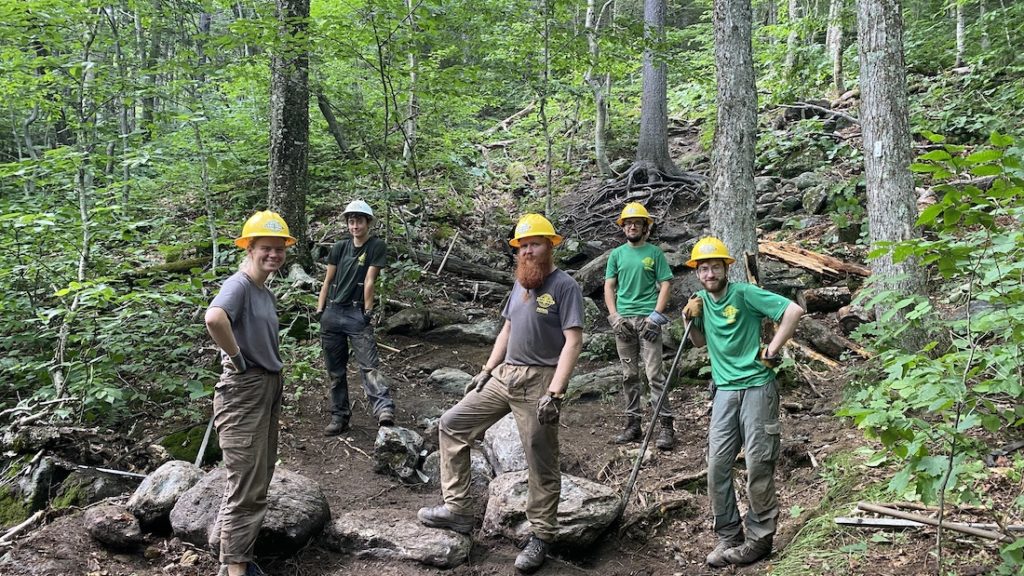 What is it like to work on a trail crew? For more than 90 years the Green Mountain Club has hired seasonal crews to live and work on our trails. The Long Trail Patrol, GMC’s professional crew, augments the efforts of the club’s hundreds of volunteers to undo the effects of erosion by water and of wear and tear by hikers. The goal: keep water off the trail, and hikers on it. The crew prioritizes skilled and demanding rock work because stone stands up to the pounding of boots and the harsh Northeastern climate.
What is it like to work on a trail crew? For more than 90 years the Green Mountain Club has hired seasonal crews to live and work on our trails. The Long Trail Patrol, GMC’s professional crew, augments the efforts of the club’s hundreds of volunteers to undo the effects of erosion by water and of wear and tear by hikers. The goal: keep water off the trail, and hikers on it. The crew prioritizes skilled and demanding rock work because stone stands up to the pounding of boots and the harsh Northeastern climate.
This year the northern crew concentrated on the Long Trail from Bruce Peak to Jay Peak, the first installment of a five-year plan to improve the Long Trail north of Route 15, the most rugged and historically underfunded stretch of the trail. GMC will field a dedicated crew to rebuild the northern trail to match the quality of the rest of the LT, which has benefitted from state and federal funding for many years. This investment will be funded by the Long Trail Legacy Campaign.
The crew started at “Site F,” a long, steep and badly eroded piece of trail just north of Route 242 near Jay Camp. Crew Lead Clara Kuhn and Field Supervisor Rosalie Sharp scouted the piece in the spring to plan at least 150 feet of restructuring and rock work. Two and a half weeks of work resulted in a new waterbar, about 15 feet of turnpike, seven check steps, and a 20-step stone staircase on the steepest section.
The story that follows, gained by observing the crew on two days separated by a week, describes just a sample of the work required for such a thorough reconstruction.
7 a.m. The crew wakes up at their “spike site,” home-away-from-home at the Jay Camp Overflow Tenting Area
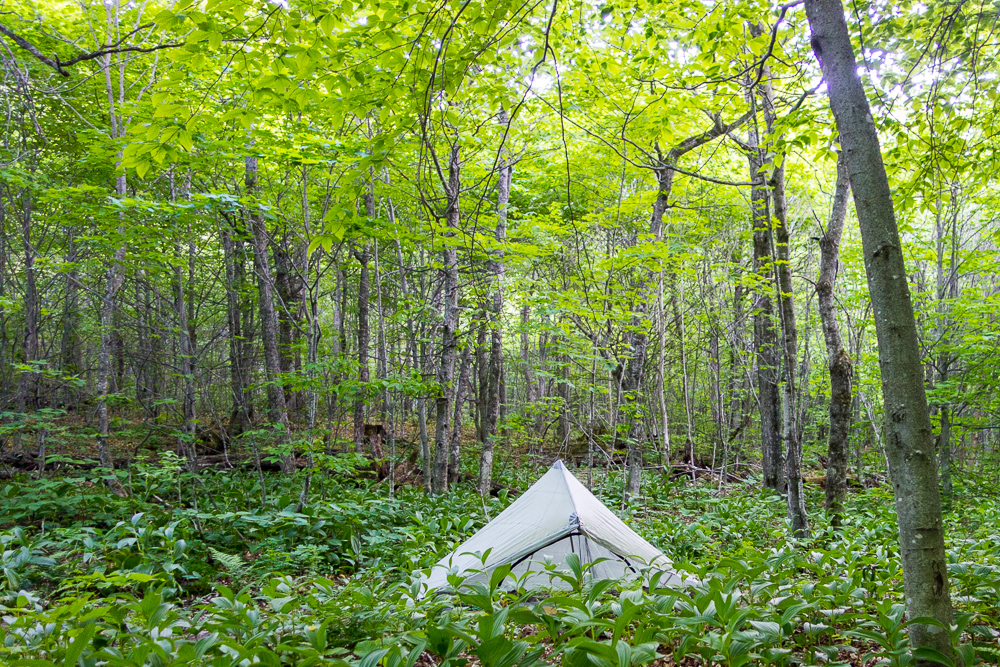
The crew — Lead, Clara Kuhn; Sam “Kenney” Kenney; Sam “B.B.” (short for Big Beard) Sylvester; Andrew Rosenthal-Baxter; and Sarah Pillard — dress in long pants, boots and a Long Trail Patrol T-shirt; and grab gloves, safety glasses and hard hats. They make their own breakfasts, lunches and snacks, and rotate turns cooking a communal dinner.
For breakfast the crew heads to the tarp-sheltered kitchen area to boil water on a two-burner Coleman stove, provided by GMC along with other kitchen gear. They carried a steel bear box to the site when they arrived, and now they hang extra cooking items high in trees. Most crew members enjoy a typical backcountry breakfast: oatmeal, peanut butter, energy bars and coffee, though Sam Kenney usually opts for ramen.
8 a.m. The crew hikes to the work site about 15 minutes from camp and preps for the day’s work.
They drop their day packs in the brush off trail, and fetch tools from a cache behind a large boulder about 50 yards off trail. For construction materials they will use rocks, soil and brush from the surrounding forest, taking care to leave little or no visible disturbance.
The crew considers the day’s plan, and splits up to tackle its components. Earlier they rebuilt a failed waterbar, and now they will create a passable and obvious route so hikers will stay on a narrow and firm footpath, allowing the formerly widened trail to revegetate and avoid further erosion.
9 a.m. The day’s first big project is placing a check step mid-way through the work site.
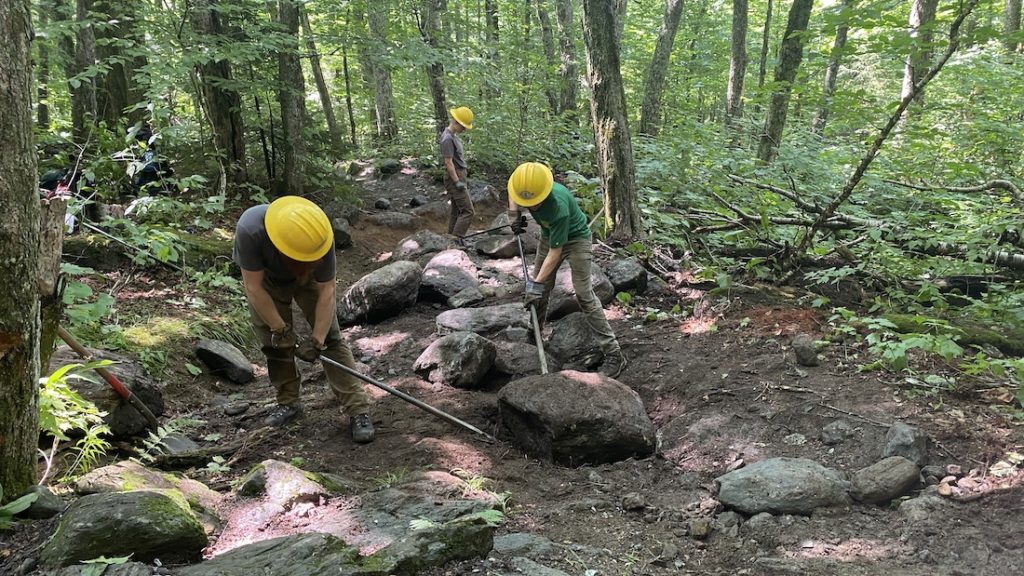
Andrew and B.B. set to work on the third check step, a massive rock with a fairly flat top set into the trail, forming a step resistant to flowing water. Check steps, quarried from the surrounding area, are typically placed three to five feet apart on gentle grades.
Using pick mattocks they carve a bed for the step, a couple feet deep and just wide enough to fit the rock. But it’s more complicated than that. A check step must be set so the supporting earth won’t settle or erode, displacing it before its time. The best steps sit sturdily on other rocks below ground rather than on impermanent earth. Crews must sometimes clip tree roots to make room for check steps, but avoid it if they can.
Next they use heavy steel rock bars and strategy—not brute force—to lever a 200-plus-pound rock into position.
10 a.m. B.B. and Andrew still struggle with their mammoth rock. It often takes hours to set a rock right, and this one is proving finicky. Each places a rock bar beneath an edge of the rock, trying to nudge it into a stable set. One slides his bar under an edge seeking a “bite,” or hold, and little by little they raise one side and shift the rock. They test the set by standing on each corner and axis of the step, sensing the slightest rocking or movement.
11 a.m. Lunch Time
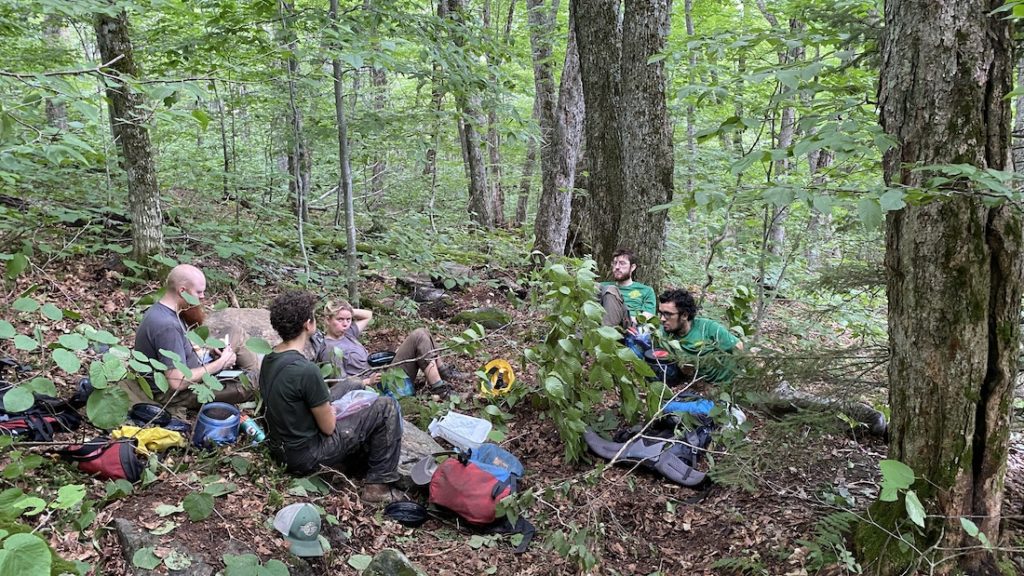
“Hey Clara, what time is it?” B.B. asks.
“It’s eleven o’clock on the dot,” says Clara — the crew’s typical lunch break.
“Well, that means this rock is going to set itself, and we can go to lunch,” quips B.B. with lighthearted sarcasm, and just a hint of frustration. A full morning of work, and nothing to show for it…yet.
Lunch is a quiet affair. Each crew member carries a bear-proof canister as a lunchbox. Calories are important; space and weight are too, though less so than on an overnight hike. Tortillas stuffed with hummus, cheese, tuna, or peanut butter are common (not all together, usually). And plenty of water.
I ask what they usually eat. Kenney says Sarah eats “stuff that requires my knife.” Sarah says she usually eats “B.B.’s apple cores” — the Leave No Trace ethic runs deep. Andrew reads an e-book on his phone, while Kenney tosses thought provoking conversation starters, like takes on the classic “trolley experiment” conundrum of the study of ethics.
11:30 a.m. Clara, in her fifth season with GMC and her first as LTP Lead, keeps a close eye on the clock. Lunch break is 30 minutes, and they break for 30 minutes at midafternoon.
11:35 a.m. Checking in on Kenney and Sarah, who are finalizing a stretch of turnpike.
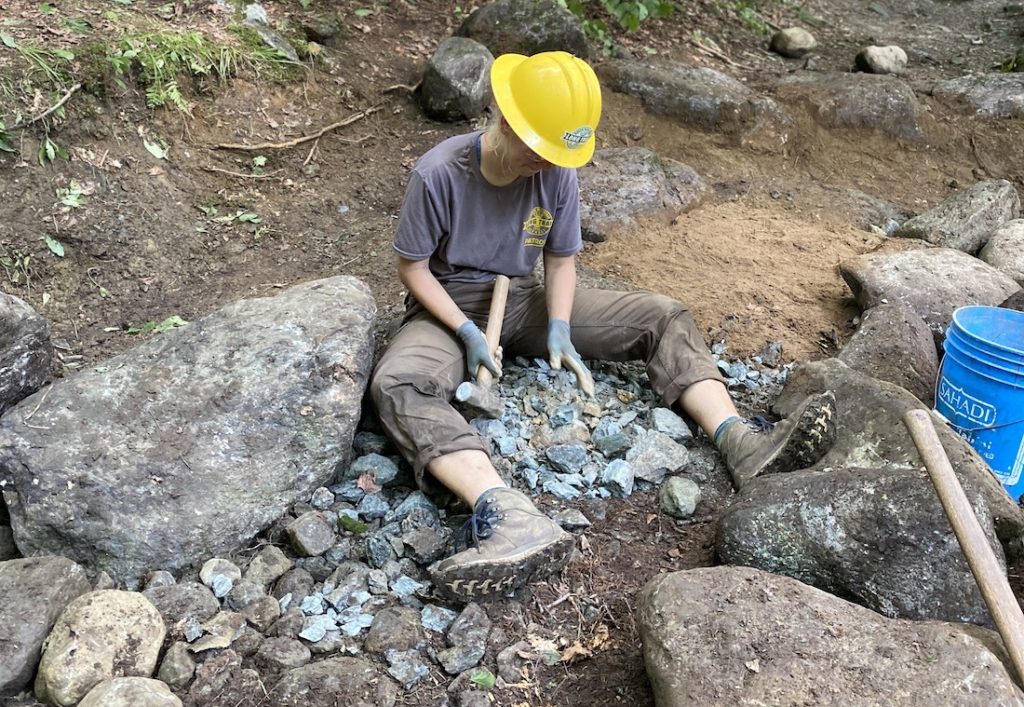
While B.B. and Andrew continue wrestling with what must be the most difficult check step in GMC history, Kenney and Sarah finalize the 15-foot section of turnpike just above the new waterbar.
Turnpikes are deceptively complex. They often raise and harden a boggy piece of trail, but this turnpike is designed to funnel hikers to a narrow path to the staircase. A turnpike is built in layers to drain water: large rocks, smaller rocks, golf-ball-size “crush,” topped with firm mineral soil. A well-constructed turnpike looks like an ordinary packed section of dirt, but there’s a lot hidden beneath the surface. Sarah makes crush, slamming mid-size rocks with a sledgehammer until they shatter, while Kenney gathers mineral soil from the pit he dug several yards off trail.
12:30 p.m. Meanwhile, B.B. and Andrew successfully set the check step into place.
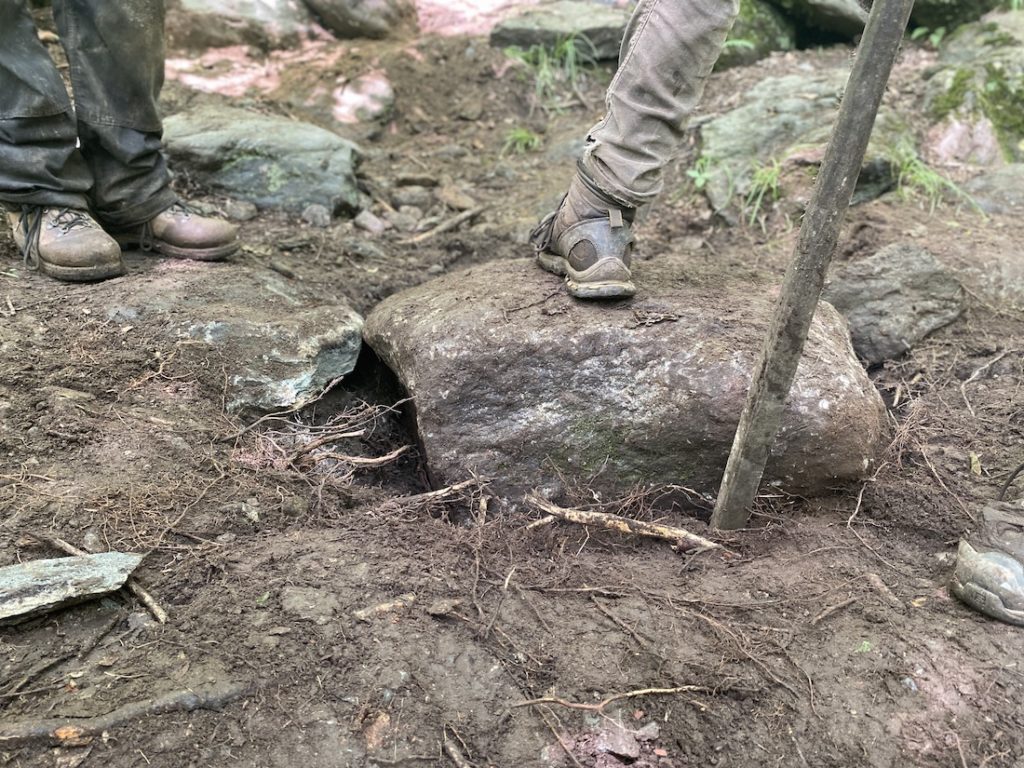
They jump heavily on it to test its security before filling in the surrounding earth with scree, crush and mineral soil. This helps create drainage as well as raises the level of the trail, so that each subsequent step is a reasonable grade up from the one that precedes it.
1 p.m. Getting down to business with the Griphoist
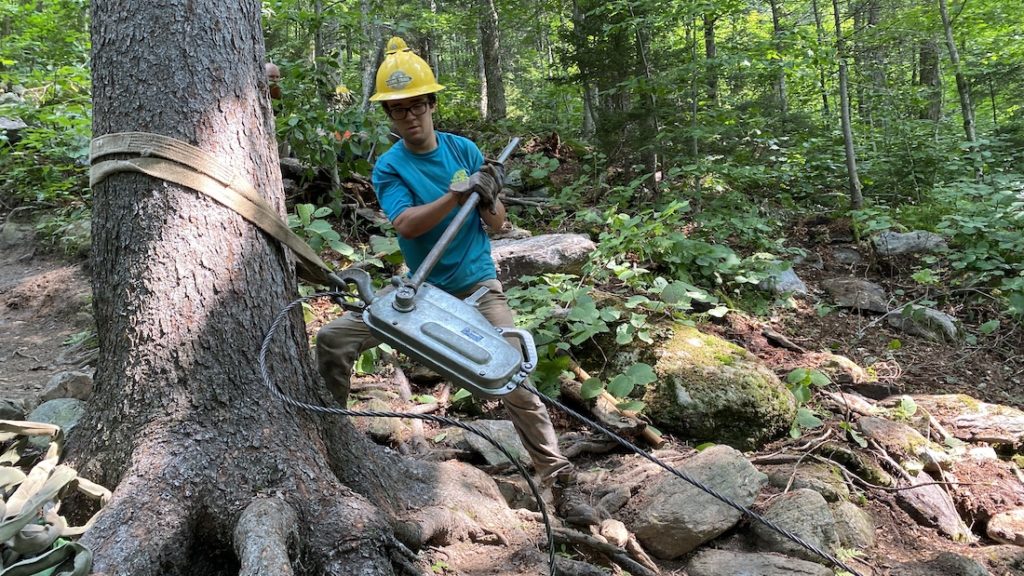 |
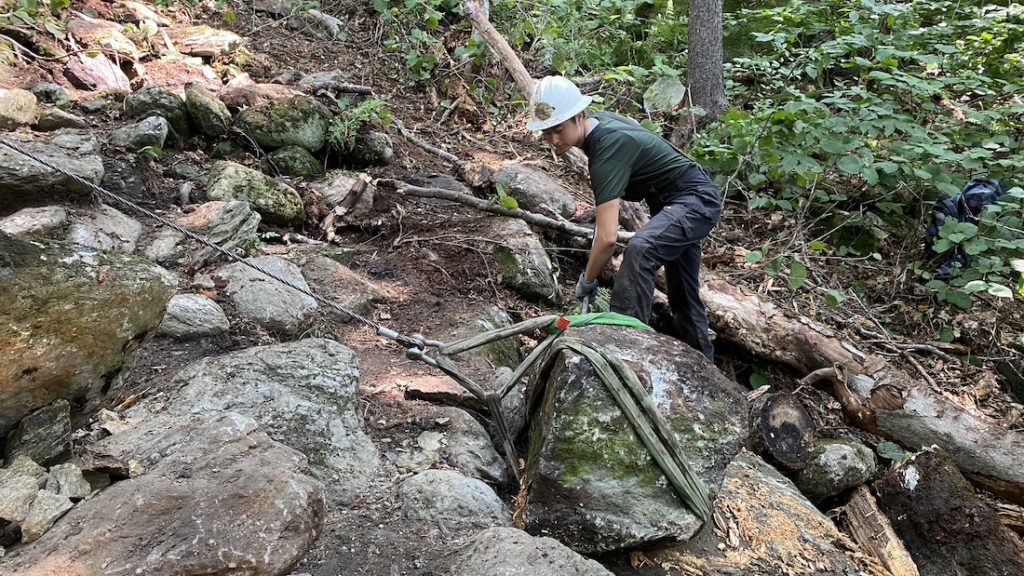 |
Left: Andrew operates the Griphoist by cranking a long metal handle. The wire rope extends from the Griphoist to the rock pictured at right, where Clara guides the rock over obstacles with her rockbar.
After the challenging rock is finally set, the crew decides it’s time to bring in the big gun: the Griphoist, a manually operated hoist that pulls wire rope with metal jaws to haul rocks uphill, through long distances, or over obstacles. This piece of trail is particularly steep, making it hard even to get a foothold, let alone a solid grip on a massive rock.
Clara reviews methods of wrapping rocks with slings made of webbing, sized for varying loads. Granite or schist, typical Vermont types of stone, weigh 150 to 175 pounds per cubic foot. Some not-so-scientific eyeballing puts these future steps at 600 to 800 pounds each.
Andrew stands at the Griphoist, which is anchored to a large tree about 20 feet uphill. Clara clips the cable to the webbing, adjusting it for the desired direction of movement. “Ten-SION!” announces Andrew as he starts to crank the metal arm of the hoist back and forth.
Slowly but steadily the slings tighten, and the rock begins to move inch by inch uphill, over the previously placed check steps, as Clara guides it over obstacles with a rock bar. This gargoyle rock is destined to form a border along the check steps to confine hikers to the staircase. Using the Griphoist is slow, but sometimes it’s the only way to shift really large rocks or maneuver them along tricky upgrades.
2 p.m. As the afternoon wears on, the crew tackles three more portions of the never-ending staircase.
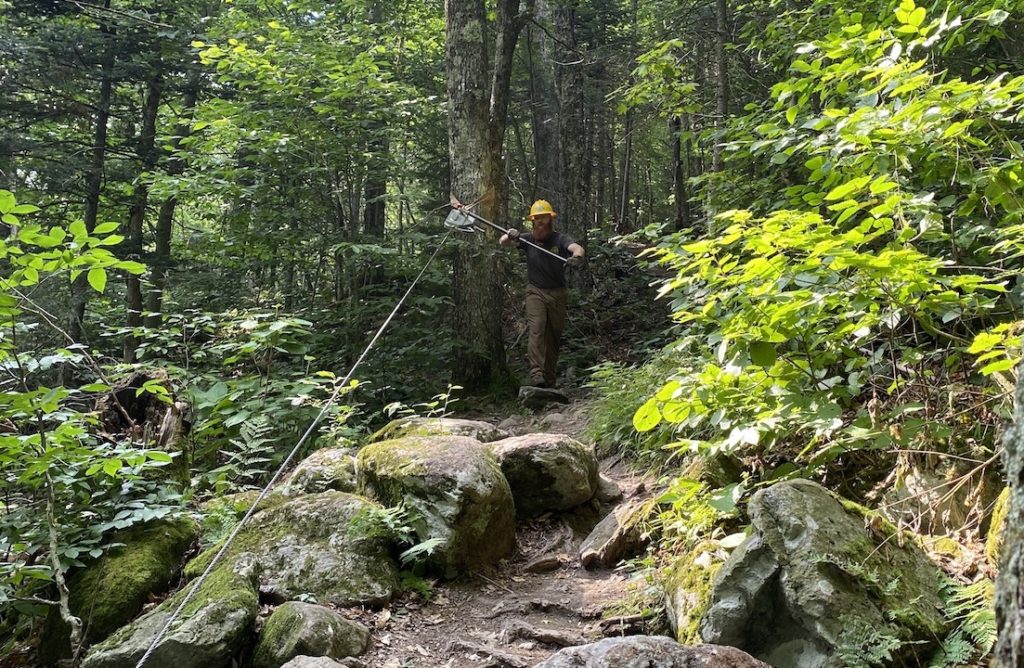 |
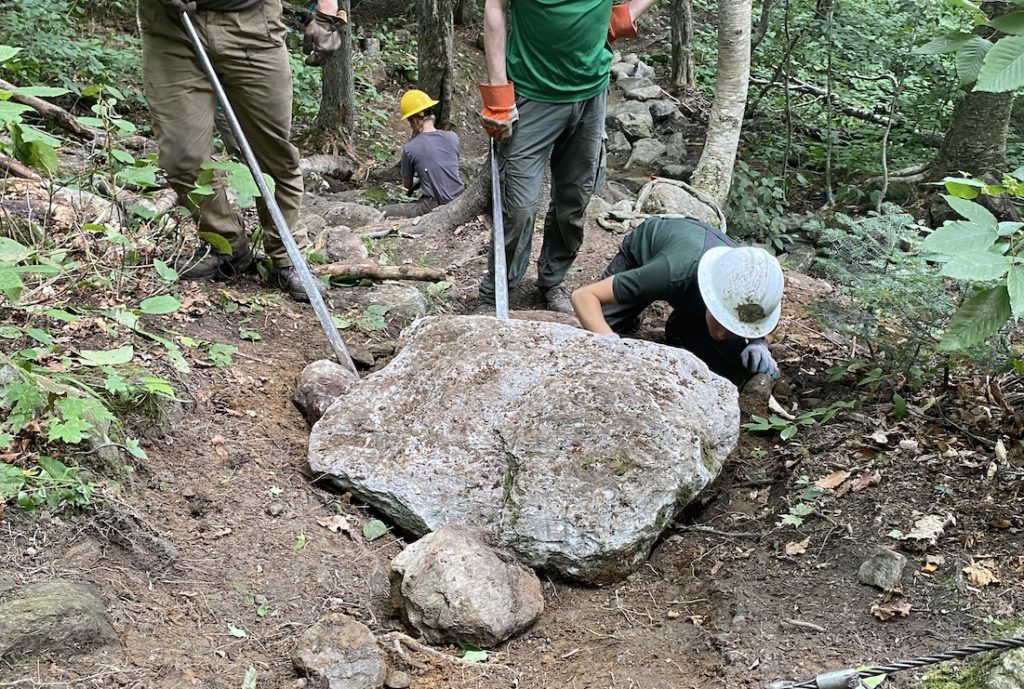 |
Kenney and B.B. anchor the hoist to different trees chosen in line with each rock’s intended destination. Repeatedly moving the heavy tackle from tree to tree is time consuming, but it’s better than a faulty position, which risks a rock slipping from its slings and skittering 20 feet downhill, where the crew takes care never to be.
2:30 p.m. The crew takes its second break, snacking, reading, or discussing weekend plans.
Reading is popular – B.B. describes his current place in Dracula, which others have recently read. Sarah is reading A Brief History of Seven Killings, while Kenney laments that he’s read everything on his Kindle, and needs to download some new options.
3:00 p.m. Kenney and B.B. are once again nudging and fudging a rock for that perfect set, this time on the upper staircase that will replace the steepest, most badly eroded section of this trail. Clara looks on with her discerning eye. The crew thinks they have a set, but Clara shakes her head and points out a subtle rocking on one axis of the step. “There are a lot of bad rock staircases out there,” she says. “This is not going to be one of them.” When the step is finally set, they quickly grab bucketfuls of mineral soil and small crush to secure and level the edges and surfaces of the step.
3:30 p.m. Hikers admire the progress and ask the crew questions as they pass.
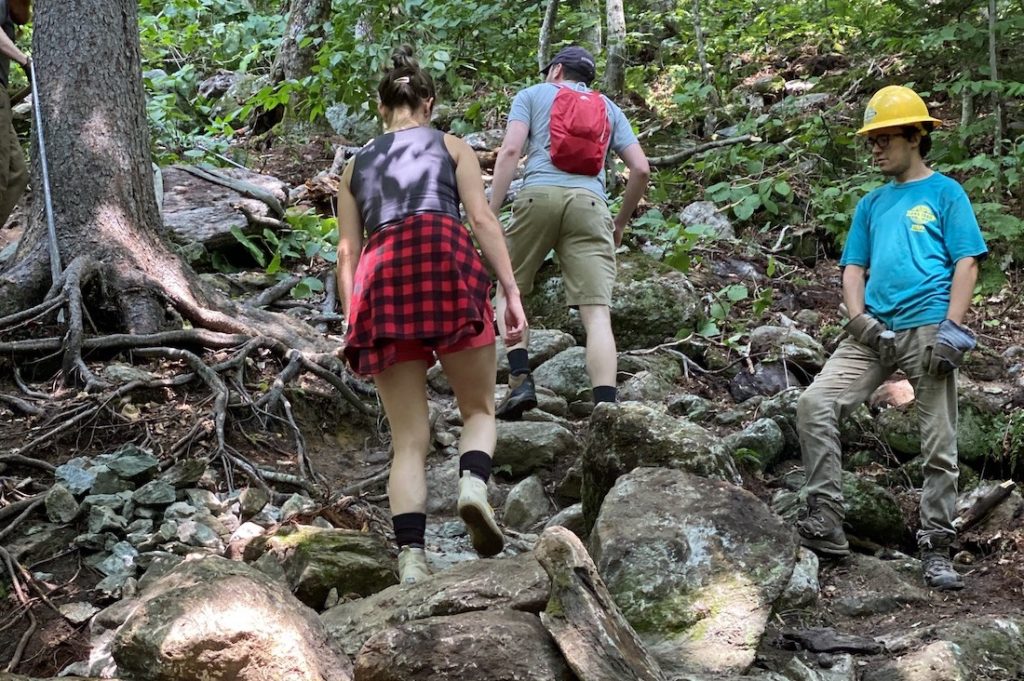
On the lower half of the staircase Andrew and Sarah pause to let some day hikers pass. Carefully watching where they go, Andrew guides them down the staircase rather than along the drainage swale, which will later be brushed in to better define the footway.
Observing hiker behavior is a valuable tool in trail maintenance as well as construction. If what hikers consider the clearest or easiest path is off the desired trail line, maintainers can install scree or other materials to delineate the proper course.
Hikers thank the crew as they descend the challenging trail. “It will be easier soon!” the crew responds.
4:15 p.m. — Winding Down on the Trail
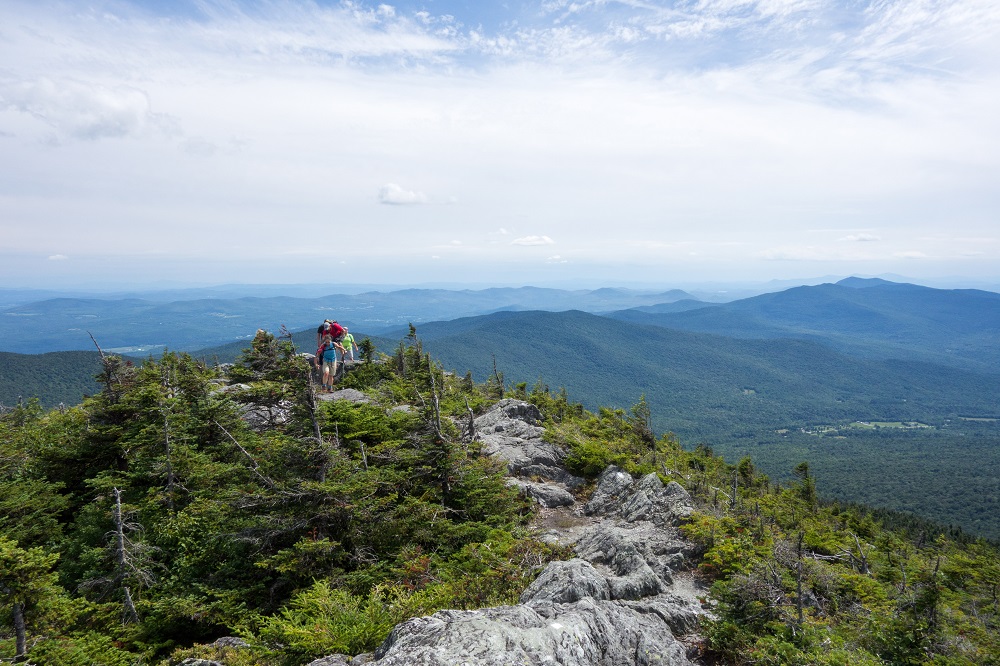
The workday is winding down, but finishing is not as simple as punching a clock. The crew can’t leave hazardous boulders half-set. They strategically finish the last big move or set, and refrain from starting what they can’t finish. They account for all tools, and re-cache them before enjoying downtime before group dinner.
The hike back to camp is quick today, and a few hours of daylight remain for a hike up Jay Peak. Andrew heads up to relax, while Kenney summits to reload his Kindle via the strong wireless signal there.
6:30 p.m. Tonight is Sarah’s turn to make dinner: burritos with black beans, rice, peppers, onion, cheese and salsa.
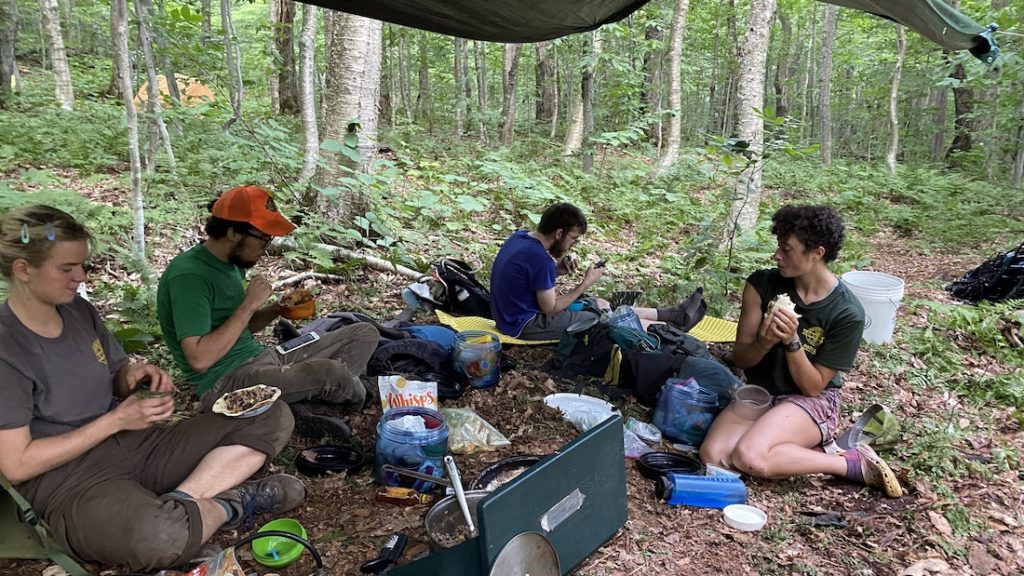
Andrew helps prep, and the whole crew makes sure there are no leftovers. After cleanup they play a round of “Midnight,” a favorite camp game involving dice. Betting coveted Fig Newtons keeps things interesting.
8 p.m. As the sun dips behind the trees, the crew retires to their tents, eager for rest before another long day of rock work.
Each increment of trail work may seem small, but at the end of each week the crew can look back with satisfaction on a vastly transformed stretch of trail, both more durable and easier to hike than the washed-out mess it was before. Well-built stone structures can easily last many decades, though the Green Mountain environment is tough, and there are no guarantees. As hiker traffic and extreme weather intensify, the club must continually adapt its trail maintenance strategies and plans.
Through funding by the Long Trail Legacy Campaign, GMC will run an additional Long Trail Patrol crew dedicated solely to the Northern Long Trail for the next five years, to help manage increased year-round use and the impacts of a changing climate, including more frequent and more intense weather events. You can support this work by donating to the legacy campaign. Thanks to everyone who has supported this work.



















[…] the Long Trail on Jay Peak, complementing the intensive staircase work the Long Trail Patrol did there this summer. Brush-ins are a trail maintenance practice used when hikers have repeatedly walked off the […]